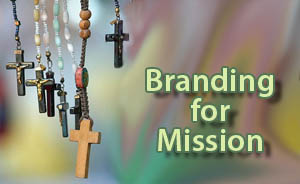Branding When Ministry Is in Decline
 Denominations are well aware that the structure of the church faces challenges. As you work on branding your ministry consider these realities. Your mission/branding efforts have the best chance for success when all leaders are on the same page.
Denominations are well aware that the structure of the church faces challenges. As you work on branding your ministry consider these realities. Your mission/branding efforts have the best chance for success when all leaders are on the same page.
This is not always the case and lay members are often the last to know. Leadership in changing this is likely to come from lay Christians.
Church leaders know:
- the church is playing a smaller role in community life.
- the traditional membership base of the Church is dwindling.
- for the first time in history the neighborhood demographics are shifting every ten years or less.
- the mission of the Church is to embrace all populations.
Knowing all this, church leaders are dedicated to the existing structure. Until recently, it has supported them reasonably well. Mission strategy was simple: replicate the same ministry in neighborhood after neighborhood.
Today, many of the solutions they present to their congregations are both destined and designed to fail.
Church professionals come to congregations and point out that if they think they are going to reach more people like them, they are mistaken. They elaborate on what is obvious to the people living in the neighborhoods: their neighborhoods are changing. They preach a future of gloom and act surprised when people don’t jump on board.
Meanwhile, congregations see opportunity. They live and work every day in their changing neighborhoods. Their children play and attend school with the new neighborhood children. They recognize that they need leaders with different training. Help is hard to find.
The Church as a whole has been caught unprepared. Changing an institution is more difficult than changing a congregation. The Church diverts attention from its own shortcomings by concentrating on the failings of lay people.
The temptation for denominational leaders is to facilitate failure.
Finding and training leaders for congregations facing modern changes is their job/mission, but it is difficult. It is often easier to just give up on congregations that are dealing with the toughest demographic changes.
They are squandering legacy — which has enormous value!
Denominational leaders are actually taught to neglect certain parishes and allow them to die. Using Church jargon, they assign “caretaker” pastors who, unbeknownst to the congregations, are expected to do nothing but hold the hands of the faithful until they quit, move or die.
Conflict results when the faithful do not cooperate with this undisclosed agenda. Suddenly, they are “the enemy.” The only way to spread the Gospel under this “mission plan” is to destroy the existing faith community and start fresh. This buys the denomination time. They do not have to provide ANY services while they work on a mission plan. Church doors are locked for a while (weeks, months or years) until the community forgets that a church was there. This, too, is part of the plan.
The problem with this approach, outside of it being wholly unChristian, is that it is fairly easy for the people making up the new demographic to see the Church behaving at its worse.
- They can see the disregard for the lay efforts of their neighbors who talked to them with pride about their church.
- They can imagine where their own commitment to any “new” church might find them in 20 years or less.
- They will sense that they are of value to the church only as long as they can contribute.
This must be recognized. The Church which was in serious decline before the recent recession is now in severe crisis. The lure of small congregations’ endowment funds and property values is tough to pass up. It has created predatory practices that are thinly disguised as “mission.”
- The hierarchy has no confidence in its own message.
- Predators soon turn to questionable, selfish strategies.
- The people who have sacrificed for ministry are expendable. If they don’t leave on their own, displace them. If they resist, sue them.
We now have enough experience to know this approach is not working. Church members, during peaceful times, are taught to believe and trust in God. It is difficult to teach allegiance to God and suddenly demand allegiance to man.
Your pastor is the first person you must convince to embrace your plan. You must appeal to the passion (which may be dormant) that led him or her to seminary in the first place.
- Make sure your pastor knows what your leaders envision and what you expect from leadership.
- If your pastor thinks he or she may need more training, try to set up an “internship” for a week or two with a mentor that is practicing the type of ministry you now need. You may have to go outside your denomination or region.
- Stress that mission is the goal. Do not let any differences become personal. If you do, your regional office will have a very long memory for any resulting problems.
- Let your pastor know that lay representatives are expected to accompany him or her on any visits with the regional office. You want to be seen as a team.





